Oregon is a diverse state with habitats ranging from deserts to thick forests and everything in between. On the ground, some of the most dangerous animals include black bears, snakes, mountain lions, elk, and coyotes, but what lurks above? Discover the most dangerous animals flying in Oregon’s skies!
Are Oregon’s Skies Dangerous?
Oregon’s skies are not a danger hotspot for humans, but there are a few animals worth watching out for that can harm humans in certain instances. Let’s discover the most dangerous animals in Oregon’s skies for us and other animals.
1. Bees
Essential pollinating bees are critical to the food chain. Without them, plus other pollinators, failing harvests would severely impact our quality of life. Bees are important, but they can be deadly in some circumstances.
A bee sting hurts and causes localized swelling, but to someone with an allergy, a bee sting has the potential to kill. Bees don’t sting unless they have to. They certainly don’t buzz around looking for victims; however, if you sat on one or it became trapped in your clothing, it may sting in self-defense.
According to Oregon’s Bee Project, 700 bee species live in Oregon, so it’s important to exercise caution if you’re allergic.
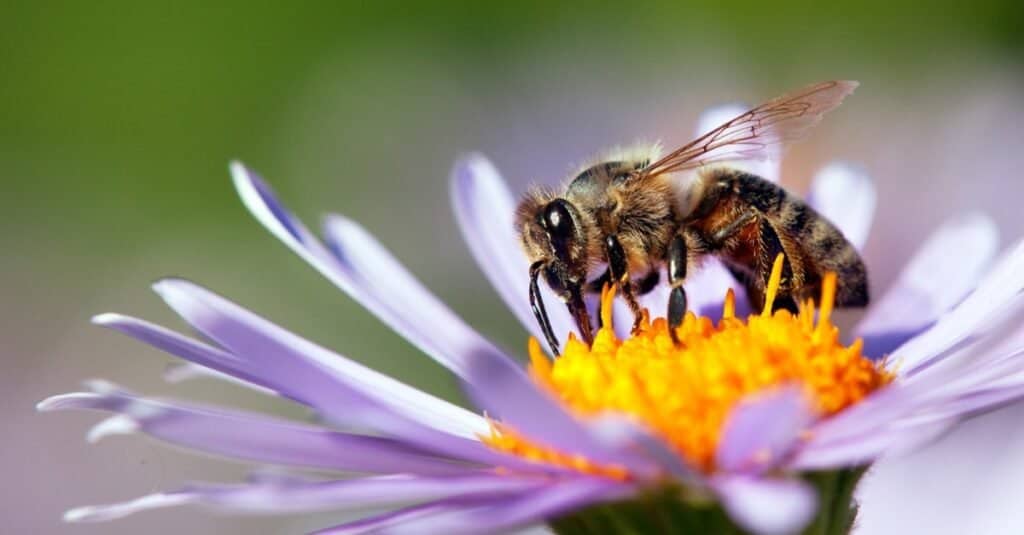
Bees are essential pollinators, but they can cause fatal allergic reactions.
©Daniel Prudek/Shutterstock.com
2. Wasps
Oregon homes several species of stinging wasps, including hornets and yellow jackets. Yellow jackets have bright yellow and black stripes, whereas brown hornets appear duller. Like bees, wasps are beneficial pollinators, and they prey on crop-damaging insects, too.
Chiefly found in social nests, these flying insects pose a danger to humans because their stings are painful and cause swelling and allergic reactions in some folks.
Disturbing a nest can lead to multiple stings from aggressive wasps. They become more aggressive in the fall when the colony begins to die off.

Yellowjackets are common in Oregon. They become more aggressive in the fall.
©Henrik Larsson/Shutterstock.com
3. Bats
Fifteen species of bat flit around Oregon’s night skies, reaching 20-30 mph when they swoop for food. Some species live in Oregon year-round, hibernating through winter, while others migrate to warmer states when temperatures drop.
Bats are carnivorous mammals that eat moths, mosquitoes, midges, and any other small flying insects, using echolocation to pinpoint the exact location. Some bat species eat thousands of nuisance insects every night!
Although bats are not aggressive towards humans, they may carry rabies, according to the Oregon Health Authority. Humans shouldn’t handle bats, especially sick or injured ones, that may bite in self-defense.
Rabies isn’t a fast-moving disease. It travels to the brain for weeks or months before flu-like symptoms appear. Delerium, confusion, hallucinations, and fear of water are common. Few animals (and people) survive it unless it’s treated immediately before symptoms arise. A doctor must see any bat bite, preferably with the biting bat, for testing.

An infected bat bite or scratch may transmit rabies.
©Rudmer Zwerver/Shutterstock.com
4. Mosquitoes
Mosquitoes are common in Oregon,; although their bite is annoying,, they are not usually dangerous. However, West Nile Virus is a disease mosquitoes may carry, and this is a danger. West Nile Virus causes flu-like symptoms and, on rare occasions, encephalitis.
Only female mosquitoes drink blood to nourish their eggs with protein. You can prevent mosquito bites in Oregon with insect repellent, long-sleeved clothing (especially in the evening when mozzies are more active), and disposing of standing water in the yard where mosquitoes breed.

Only female mosquitoes drink blood to obtain protein for egg laying.
©Anest/Shutterstock.com
5. Bald Eagle
Epic bald eagles are a dangerous animal flying in Oregon’s skies, but not to humans unless you find one injured and attempt to pick it up. Call a wildlife rehabilitation center for advice if you discover a grounded bald eagle.
It’s one of the largest raptors in North America and known as the symbol of freedom, but distinctive bald eagles don’t actually have bald heads! Instead, they display white head feathers that stand out against their brown bodies. A bald eagle’s wingspan can reach a whopping seven feet wide, and their sharp yellow talons hook fish and small mammals.
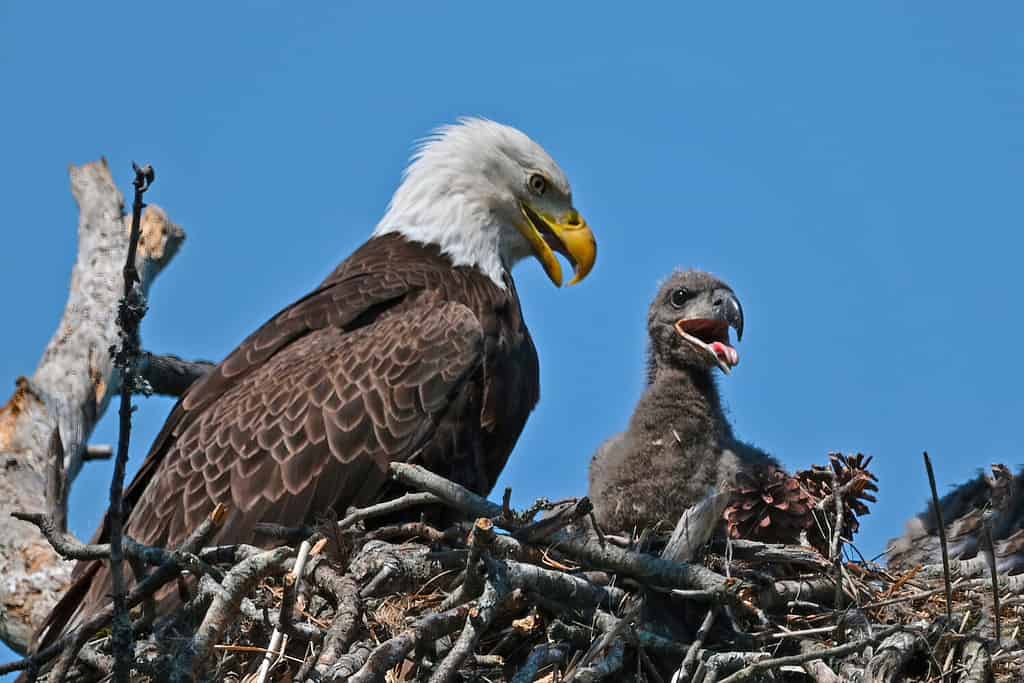
A bald eagle’s wingspan can reach seven feet wide.
©Brian E Kushner/Shutterstock.com
6. Horse Fly
Horse flies deliver a painful bite to horses and humans. Whilst they’re mostly a nuisance to livestock, their slashing bite causes pain and swelling in humans, too. On occasion, bites become infected or cause an allergic reaction.
This biting fly doesn’t take time to numb an area before taking a drink of blood like sneaky mosquitoes do. Instead, it slashes skin open with serrated mandibles and laps up the blood spill. Only female horse flies drink blood at mating time in order to reproduce. Males, however, feast on flower nectar.
Horseflies are most common in the summer months, and although they’re not the most dangerous animal flying Oregon’s skies, hordes of biting horseflies cause real distress to large mammals like horses and cows.

In the summer months, female horseflies torment horses and cattle.
©iStock.com/MegaV0lt
7. Peregrine Falcon
Speedy peregrine falcons are the fastest animal on earth, with a recorded diving speed of 240 mph. They prey on other birds, including ducks and pigeons, and due to their unerring skill, falconers have used them for thousands of years.
Peregrine falcons live on every continent except Antarctica. In Oregon, they are not a danger to humans, but to their grabbed in mid-air prey, they’re terrifying. Bold peregrine falcons aren’t afraid of a tussle, either. They’ve been observed in Oregon’s skies stealing fish from bald eagles and ground squirrels from osprey.
A hooked beak, grey-brown feathers, and dark tear marks distinguish this incredible raptor.

Peregrine falcons live on every continent except Antarctica.
©Harry Collins Photography/Shutterstock.com
8. Flying Squirrels
In the heavily forested areas of Oregon, flying squirrels move between tree tops. They don’t actually fly but rather glide using skin that extends from their front to their hind legs
Of Oregon’s four squirrel species, the northern flying squirrel is. the least seen. They’re nocturnal and need lots of trees to move around safely on their specially adapted “wings.” Therefore, they stick to heavily forested areas. Lichens, fungi, seeds, nuts, bird eggs, nestlings, and insects form the bulk of their diet, and they make nests from tree bark to raise one to two litters yearly.
Northern flying squirrels are shy, secretive creatures that aren’t dangerous to humans. There are no rabies reports involving them in Oregon, but they do have a very sharp bite when threatened.
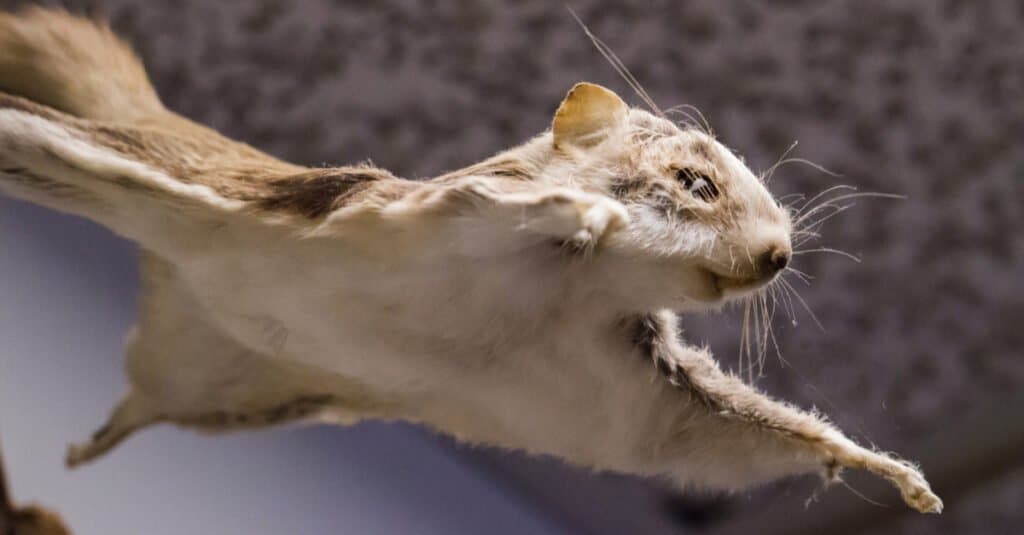
Flying squirrels use skin flaps to safely glide between treetops.
©Laura Fiorillo/Shutterstock.com
9. Biting Midge
Tiny biting midges are difficult to spot. The first time you’ll know about this flying menace in Oregon is often painful, itchy bites. Because they congregate in number, a midge cloud can deliver dozens of bites in a very short time.
These minuscule insects are most active during dusk and dawn. They prefer damp, swampy areas, but yard ponds and riversides are midge des-res areas, too. The best ways to avoid an itchy bite or 100 are long sleeves, long trousers, and insect repellent.
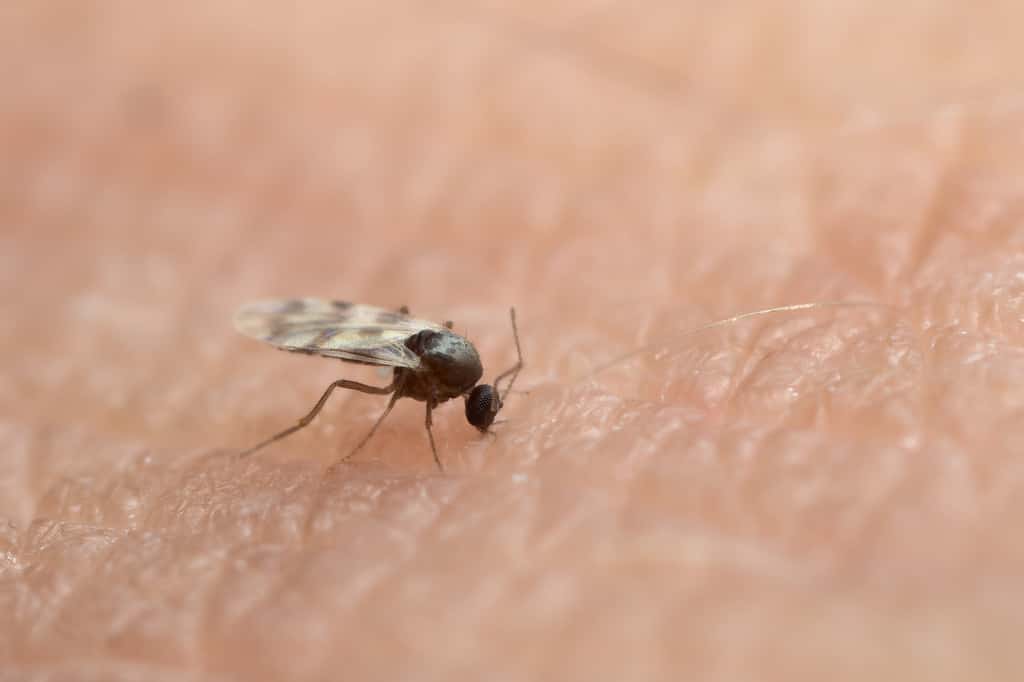
Tiny biting midges cause itchy, red, and sometimes painful lumps.
©Henrik Larsson/Shutterstock.com
10. Great Horned Owl
Another of Oregon’s spectacular raptors is the great horned owl. They live in all of Oregon’s forests, cities, and deserts but present no danger to humans unless they are threatened and need to defend themselves, in which case their ferocious talons and sharp beaks cause deep lacerations.
With a 45-inch wingspan, mottled gray-brown feathers, and white throat, this no-fear mega-owl is easy to recognize. These epic birds prefer to hunt at dusk, preying on small mammals like squirrels and mice, but they also grab rattlesnakes, skunks, herons, and young raptors, including peregrine falcons! In other states, great horned owls even take young alligators!
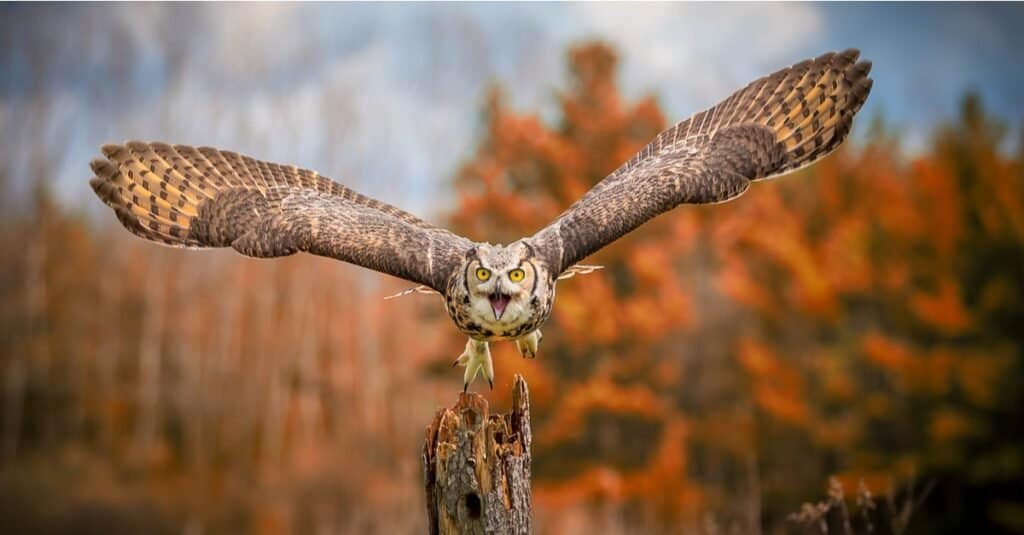
Great horned owls will prey on snakes, skunks, and peregrine falcons.
©Imran Ashraf/Shutterstock.com
10 Million Years Ago in Oregon’s Sky: Pterosaurs!
Even a great horned owl would think twice about taking on this flying predator.
Millions of years ago, the most dangerous animals flying in Oregon’s sky were flying reptiles like the epic pterosaurs. This extinct flying reptile existed 228 to 66 million years ago in the Late Triassic to the end of the Cretaceous period.
Paleontologists have recently unearthed evidence that a colony of 13-foot-wingspan Bennettazhia pterosaurs lived in central Oregon on cliffs, much like modern-day seagulls do now.
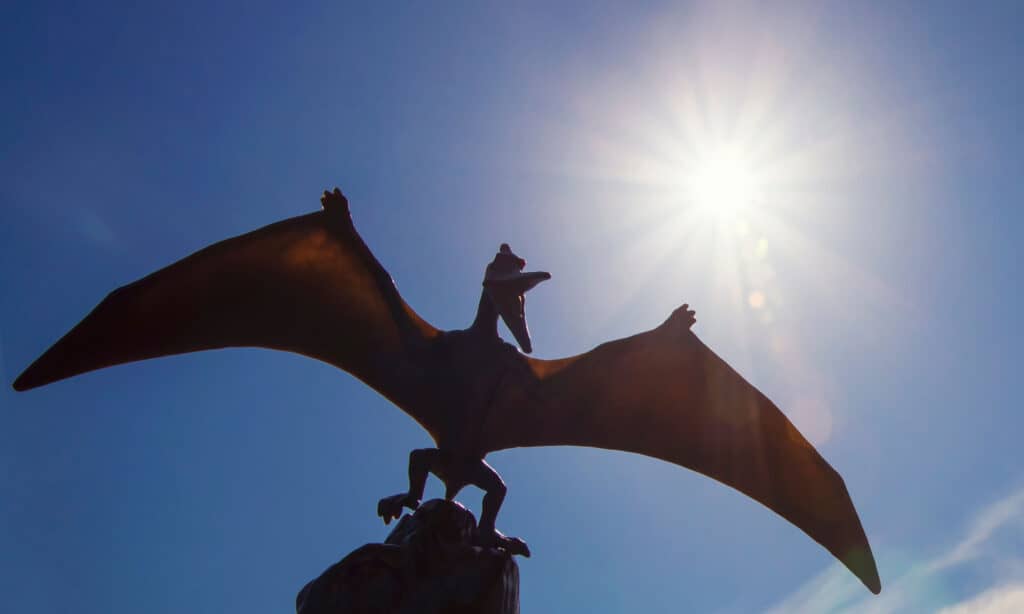
Flying pterosaurs roamed Oregon’s skies millions of years ago.
©Marti Bug Catcher/Shutterstock.com
What’s Oregon’s Most Dangerous Flying Animal?
Oregon’s modern-day skies are a relatively danger-free zone for us. The most dangerous flying animal there is probably a disease-carrying mosquito or perhaps a bee or wasp if you’re allergic.
However, that’s not the case for animals hunted by Oregon’s flying predators. A peregrine falcon, the fastest animal on earth that plucks and eats its unfortunate victims alive, and the awe-inspiring great horned owl that’s seemingly afraid of nothing are two of the most dangerous flying animals in Oregon’s sky to them, for sure.
The photo featured at the top of this post is © iStock.com/R Lolli Morrow
Thank you for reading! Have some feedback for us? Contact the AZ Animals editorial team.






